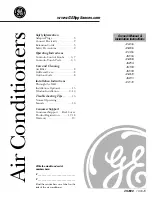
9
5. Insulation of Refrigerant Tubing
This outdoor unit uses a system of capillary tubes, which cause
both the wide and narrow tubes to become cold.
To prevent heat loss and condensation, these tubes must be
adequately insulated. Thickness of the insulation material should
be a minimum of 8 mm.
Insulation Material
The insulation material must have good insulating characteristics,
must be easy to use, be age resistant, and must not easily absorb
moisture. Either polyethylene or foam rubber insulation is
recommended.
When applying the insulation, first connect the refrigerant tubing to
the outdoor unit. After performing a leak test on the connecting
part, insulate it, then wrap it with vinyl masking tape.
6. Tubing to be Used
Deoxidized annealed copper tube must be used for the refrigerant
tubing. The diameter and thickness are listed in Table 3.
Table 3
7. Tubing Connection
Tighten up the union connection portion of the indoor unit using
a double spanner. (Fig. 7-1)
Connect both the wide and narrow tubes of the outdoor unit.
(Fig. 7-2)
When using the torque wrench, be sure to apply the correct torque
according to the tubing diameter as given in Table 4.
Table 4
Fig. 7-1
Indoor unit
Outdoor unit
Fix
Torque wrench
Tubing Diameter
Tightening Torque
6.35 mm
Approx. 150 – 200 kg-cm
9.52 mm
Approx. 350 – 400 kg-cm
12.7 mm
Approx. 500 – 550 kg-cm
Combination
Narrow Tubing
Wide Tubing
Outdoor unit
Indoor unit
Outer Dia.
Thickness
Outer Dia.
Thickness
GRV340
MCAV92/CAV92
6.35 mm 0.8 mm 9.52 mm 0.8 mm
MCAV/KPAV180 6.35 mm 0.8 mm 12.7 mm 0.8 mm
min.
8 mm
Fig. 5-1
Insulation
Thickness:
min. 8mm
Min.
8mm
CAUTION
!
After a tube has
been insulated,
never try to bend it
into a narrow
curve, as this may
cause the tube to
break or crack.
Insulation
Fig. 5-2
NOTE
Unit A, B ........ MCAV92/CAV92
Unit C ............. MCAV/KPAV180
Fig. 7-2
Narrow
tube
Wide tube
Unit A
Narrow
tube
Wide tube
Unit B
Wide tube
Narrow
tube
*Capi box
Unit C
* Remove this capi box when installing the
optional Dual System Kit (DKR8585C).




































